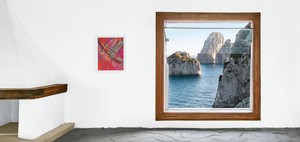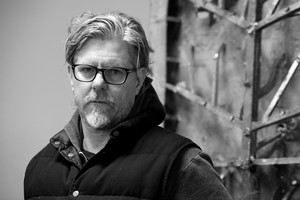
The Nature of Mark Grotjahn
Michael Auping writes about the origins of Mark Grotjahn’s Capri paintings and their relationship with nature and landscape.
Because I have an active and obsessive eye‚ I’m interested in finding as much contentment as I possibly can. In my work I create problems and then solve them in order to feel peace.
—Mark Grotjahn
Mark Grotjahn combines gesture and geometry with abstraction and figuration in visually dynamic paintings, sculptures, and works on paper. Each of his series reflects a range of art-historical influences and unfolds in almost obsessive permutations.
Grotjahn was born in Pasadena, California. He received a BFA from the University of Colorado at Boulder and an MFA from the University of California at Berkeley. While studying in California, he began his first major project, Sign Exchange (1993–98), in which he painted replicas of signs that he saw in stores around Los Angeles, then had the store owners display his hand-painted versions in place of the originals. In 1995 Grotjahn was an artist-in-residence at the Skowhegan School of Painting and Sculpture in Madison, Maine. He moved to Los Angeles a year later and, with his classmate Brent Petersen, opened the short-lived gallery Room 702.
In 2001 Grotjahn began the Butterfly series. These geometric paintings and drawings explore the constructs of dual and multi-point perspective and take on various forms as Grotjahn alters their composition and color. A selection of multicolored and monochromatic Butterfly works on paper were exhibited in 2005 at the Hammer Museum, Los Angeles. In 2018 the Los Angeles County Museum of Art presented 50 Kitchens (2013–18), from the same series, a work with more than fifty parts that all evolved from a single composition and incorporate residual traces of earlier drawings. Continuing his investigations of symmetry, perspective, and form, Grotjahn began the Face paintings in 2003. These expressive, anthropomorphic works of cardboard on canvas often feature sections cut away to reveal painted canvas beneath. As the series progresses, the faces become less apparent and more abstract, their curved lines creating void-like apertures.
Alongside his painting practice, Grotjahn has been making masks since 2000, painting cardboard boxes lying around his studio and affixing paper tubes between cut-out “eyes.” The Masks (2000–), although originally approached as a less formal project, came to assert themselves as a new armature for his painting. In 2010 Grotjahn started casting the Masks in bronze. In many of the sculptures, he incorporated and retained remnants of the bronze casting process, such as the sprues and runners, into his final work. As he does with his paintings, Grotjahn often boldly signs the Masks, allowing his signature to come forward as a compositional element. In 2014 the Nasher Sculpture Center in Dallas presented the first museum exhibition of Grotjahn’s sculpture, including small-scale and larger freestanding works.
In 2016 Grotjahn began the Capri works (2016–), seeking to break away from the Face paintings in favor of a more experimental, spontaneous working process. The first Capri works, New Capri, were modestly scaled paintings created for a private presentation at Casa Malaparte in Capri, Italy. Following this exhibition, Grotjahn created the Capri paintings (2016–), followed by the Free Capri series (2018–), in which he introduced the technique of scraping out areas of thick paint, then placing the resulting “slugs” in rows and grids elsewhere on the canvas.
As the Butterflies, Faces, Masks, and Capri series continue to expand, Grotjahn uses Instagram to further experiment with repetition and juxtaposition, employing the grid format to freely arrange images in different combinations, in a form of visual tic-tac-toe. Throughout his work, by finding variations within his immediately identifiable style, Grotjahn reveals the complexities of authorial gesture.

Request more information about
Mark Grotjahn